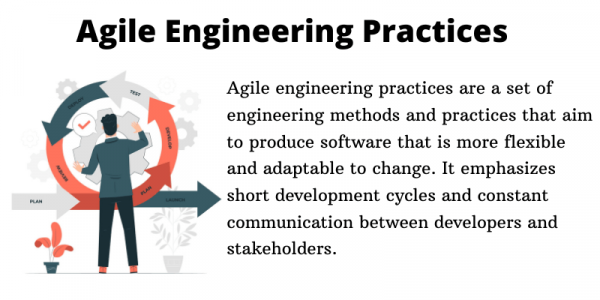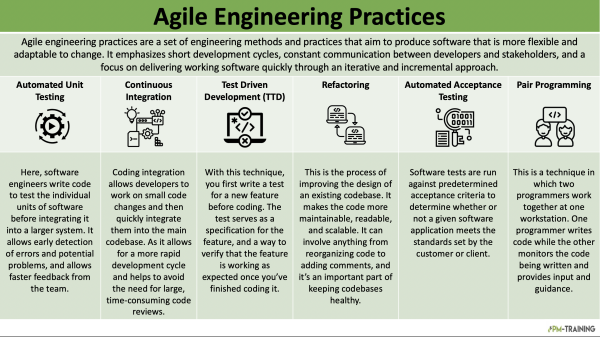Agile engineering best practices are a set of engineering methods and practices that aim to produce software that is more flexible and adaptable to change. It emphasizes short development cycles, constant communication between developers and stakeholders, and a focus on delivering working software quickly through an iterative and incremental approach.
Agile engineering is a set of engineering practices that emphasizes the rapid development of high-quality software. It is a boost-up response to the traditional models like the V model of software development, in order to improve processes by reducing the costs of losses and changes.
This approach focuses on delivering software in short cycles, or sprints. This allows for more frequent feedback and allows the team to make changes more quickly. It also places a strong emphasis on collaboration between developers, testers, and customers.
Benefits of agile engineering practices
- Reduced risk: By working in short iterations, agile teams can quickly adapt to changing requirements and feedback. This reduces the risk of the project failing to meet its objectives at a more automated pace.
- Improved quality and Speed of delivery: Agile teams typically have a higher focus on quality and testing, which leads to improved software quality and efficiency.
- Enhanced teamwork: The agile framework promotes collaboration and teamwork, which improves team morale and communication.
- Increased customer satisfaction: Agile teams deliver working software to customers at regular intervals, which leads to increased customer satisfaction.

Agile Engineering Practices in Software Development
Developing software can be a complex and time-consuming process. But by using Agile methodologies, software development teams can streamline their workflow and get their product to market faster by using the right tools and practicing them efficiently. Some common agile engineering practices are:
Automated Unit Testing
This is a practice in which software engineers write code to test the individual units of software before they are integrated into a larger system.
This helps to ensure that the software is of high quality and reduces the number of bugs that make it into the final product.
Also, it allows for early detection of errors and potential problems, and also it allows for faster feedback from the software engineering team, as the tests can be run automatically and do not require manual input from testers.
Overall, automated unit testing is a valuable practice for software engineers, as it helps to improve the quality of their code and the products they produce.
Continuous Integration
This is the process of incorporating new code changes into an existing codebase. This is typically done using some kind of automated tools, such as a continuous integration server.
Coding integration is an important part of agile engineering practices, as it allows developers to work on small code changes and then quickly integrate them into the main codebase. As it allows for a more rapid development cycle and helps to avoid the need for large, time-consuming code reviews.
Overall, it helps to speed up the development process and improve code quality.

(TTD) Test Driven Development
With this technique, in which you first write a test for a new feature before you start coding, the test serves as a specification for the feature, as well as a way to verify that the feature is working as expected once you’ve finished coding it.
It is considered an important part of the agile software development process, as it helps you catch errors early and ensures that your code is of high quality. It also forces you to think about the design of your code before you start writing it, which can save you time in the long run.
Refactoring
Refactoring is the process of improving the design of an existing codebase. It’s usually done during sprints, in order to make the code more maintainable, readable, and scalable.
It can involve anything from reorganizing code to adding comments, and it’s an important part of keeping codebases healthy. It’s also a key part of Agile engineering practices since it helps teams move faster and deliver better software.
Automated Acceptance Testing
Here the software tests are run against predetermined acceptance criteria to determine whether or not a given software application meets the standards set by the customer or client. This type of testing is different from unit testing which tests the individual parts or units of code and instead focuses on testing the functionality of the application as a whole.
Pair Programming
This is a technique in which two programmers work together at one workstation. One programmer writes code while the other monitors the code being written and provides input and guidance. Pair programming is a popular technique in Agile software development, as it can help reduce waste and improve code quality.
It can be an effective way to improve code quality and reduce waste because it allows two developers to review code as it is being written. The two developers can catch errors and potential problems early on, and they can provide each other with feedback and ideas. In addition, pair programming can help improve communication and collaboration between team members.
Best Practices for Agile Engineering
Agile engineering practices are all about being proactive and adaptive to change.
When changes happen, Agile teams are able to quickly adapt their plans and continue working towards their goal. To be successful with Agile engineering, there are a few best practices that teams should follow.
- Be flexible and adaptable
- Work in short cycles
- Focus on customer needs
- Use collaboration and communication
And don’t forget to be open to change and proactive
What is Agile Engineering?
Agile engineering is a software development methodology that emphasizes the ability to make changes quickly and efficiently. It is based on the principles of the Agile Manifesto, which stresses the importance of collaboration, customer satisfaction, and working in short cycles (known as sprints) to deliver software quickly and efficiently.
What are the 4 key principles of Agile?
The manifesto outlines four key principles that agile developers should follow: Individuals and interactions over processes and tools, Working software over comprehensive documentation, Customer collaboration over contract negotiation, and Responding to change over following a plan
What are the popular techniques in Agile Engineering?
Agile engineering practices include test-driven development, refactoring, TTD, AUT, Pair Programming, and refactoring among others. These practices help agile teams move faster and be more responsive to changes.
